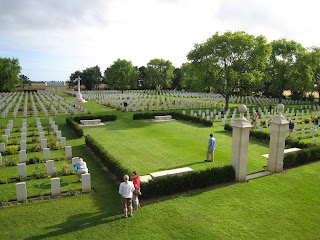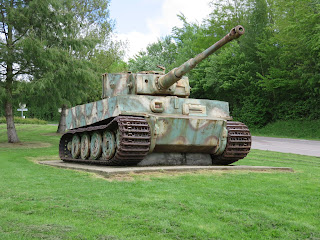Hangard Wood British Cemetery lies just in front of the portion of the front line held by the 13th Battalion (Royal Highlanders of Canada) -- the Black Watch -- at the beginning of the Battle of Amiens. The immediate area had been captured by the Germans during the 1918 spring offensive but was quickly taken by the Canadians once the Amiens show kicked off on 8 August.
The cemetery contains a number of French burials from earlier fighting in the area, alongside those from the Commonwealth.
Among the Canadian casualties in Hangard Wood is Victoria Cross winner Private John Bernard Croak of the 13th Battalion, who fell on the first day of the Battle of Amiens. The inscription chosen by his family suggests a different sort of message than one usually sees on the headstones: "Do you wish to show your gratitude? Kneel down and pray for my soul."
An ironic and somewhat chilling name is found on this headstone: Private J. Death of The Queen's (Royal West Surrey Regiment), killed during the German spring offensive of 1918.
After leaving Hangard Wood and the Canadian start line for the Battle of Amiens, I headed toward Caix British Cemetery, the location of which was right in the middle of the Canadian portion of the Amiens battlefield. The Canadian Corps, in fact, stopped on a line just east of Caix at the end of the day on 8 August, having advanced eight miles. The battle resumed on 9 August and continued for another ten days until it was called off in the face of stiffening German resistance as the enemy retreated into the old 1916 Somme defences. On the way to the Commonwealth cemetery, I passed this rather neglected German cemetery.
This is the first military cemetery from either World War that I have seen looking so run-down, whether German, Commonwealth, French, Polish, or American.
A short way up the road from the German cemetery, I found the reason for my visit to this part of the battlefield. Back in 2006 a collection of human remains was found on private property near the easternmost edge of the Amiens battlefield. Casualty investigation by Canada's Department of National Defence identified the eight bodies as members of the 78th Battalion (Winnipeg Grenadiers). The men had died on 11 August as the battalion pushed into the town of Hallu, part of the old German trench system. Five of the eight men were positively identified from DNA evidence, and they had been reinterred at Caix a couple of days before my visit. The previous summer, I had been present at Minto Armoury in Winnipeg on the day of the announcement that these men had been identified, and this trip brought me too close not to pay my respects at their final resting place.
After leaving Caix, I headed northwards to explore the Canadian battlefields along the road from Arras to Cambrai. Before I left the Somme battlefields, I passed by the Australian memorial at Bullecourt. As the Canadian Corps was completing its capture of Vimy Ridge in April 1917, the Australians launched a hasty attack to the south, targeting a section of the formidable Hindenburg Line defences. In a series of actions extending into early May 1917, the Australians lost over 10,000 casualties. Their gains were subsequently lost the next year during the German spring offensive.
"The Digger."

It was getting late by the time I reached the battle area south-east of Arras, which was the scene of the Canadian Corps' greatest achievements -- according to Lieutenant-General Sir Arthur Currie, at least. I took a quick look at the Canadian memorial at Dury, which marks the breaking of the Drocourt-Queant Line -- the northern hinge of the Hindenburg Line defences -- at the beginning of September 1918.
The inscription on the stone reads: "The Canadian Corps 100,000 strong attacked at Arras on August 26th 1918, stormed successive German lines and here on Sept. 2nd broke and turned the main German position on the Western Front and reached the Canal du Nord."
stone reads: "The Canadian Corps 100,000 strong attacked at Arras on August 26th 1918, stormed successive German lines and here on Sept. 2nd broke and turned the main German position on the Western Front and reached the Canal du Nord."
 stone reads: "The Canadian Corps 100,000 strong attacked at Arras on August 26th 1918, stormed successive German lines and here on Sept. 2nd broke and turned the main German position on the Western Front and reached the Canal du Nord."
stone reads: "The Canadian Corps 100,000 strong attacked at Arras on August 26th 1918, stormed successive German lines and here on Sept. 2nd broke and turned the main German position on the Western Front and reached the Canal du Nord."First thing next morning I headed for the site where the Canadian Corps made its assault crossing of the Canal du Nord, catching this site en route.
This is the spot where the Canadians crossed the canal on 27 September. Recognizing that this section of the canal had not yet been completed and remained dry, it is difficult now to appreciate how difficult an obstacle it presented. This is the "Canadian" side of the canal.

Things look quite different from the "German" side of the canal. The steep bank is visible in the middle of the photo. Little cover from German fire was available to the Canadians coming over the canal bank here.
Once over the canal, the ne
 xt main objective was Bourlon Wood. Seen here at a distance of roughly five kilometres from the eastern side of the Canal du Nord, the importance of the high ground at the wood seems obvious.
xt main objective was Bourlon Wood. Seen here at a distance of roughly five kilometres from the eastern side of the Canal du Nord, the importance of the high ground at the wood seems obvious.
The Canadian memorial park at Bourlon Wood. These trees lining the path up to the memorial survived the battle.
This was the last, chronologically, of the eight major Canadian battles that were memorialized in stone. Apart from the unique projects at Vimy Ridge and St. Julien (Ypres), these octagonal granite blocks were placed to commemorate the battles for Courcelette, Hill 62 (Mount Sorrel -- Ypres), Passchendaele, Amiens, Dury (the DQ Line), and, here, Bourlon Wood. The inscription reads: "The Canadian Corps on 27th Sep. 1918 forced the Canal du Nord and captured this hill. They took Cambrai, Denain, Valenciennes & Mons, then marched to the Rhine with the victorious Allies."
The Canadian battles of the Last Hundred Days constituted the highest achievement of Canadian military forces in our history. At a time when the British Army was largely worn out, the Canadian Corps -- bolstered by reinforcements from the disbanded 5th Division in Britain and by conscription -- spearheaded the Allied advance on the northern part of the Western Front. In three months of unrelenting offensive action, the Canadians led the way in breaking the last German defences in France and Belgium, leaving the enemy with little option but to ask for an armistice. The intensity of the operations was revealed by its cost: over the course of the Hundred Days, the Canadian Corps suffered 20 per cent of the casualties it sustained over the entire course of the war dating back to the spring of 1915. It is a real shame that these battles -- overshadowed as they are by the stunning success at Vimy Ridge -- are so little known by Canadians. So too the man who played such an important role in orchestrating the Corps' operations after Vimy, Sir Arthur Currie.



























































